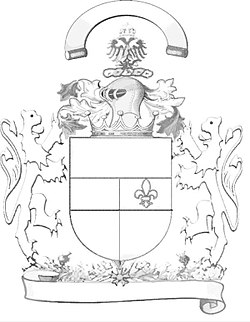Deer
| Deer Temporal range: Early Oligocene–Recent PreЄ Є O S D C P T J K Pg N | |
|---|---|
 | |
| Images of a few members of the family Cervidae (clockwise from top left) consisting of the red deer, the sika deer, the barasingha, the reindeer, and the white-tailed deer. | |
Scientific classification | |
| Kingdom: | Animalia |
| Phylum: | Chordata |
| Class: | Mammalia |
| Order: | Artiodactyla |
| Infraorder: | Pecora |
| Family: | Cervidae Goldfuss, 1820 |
| Subfamilies | |
| |
 | |
| Combined native range of all species of deer | |
Deer (singular and plural) are the hoofed ruminant mammals forming the family Cervidae. The two main groups are the Cervinae, including the muntjac, the elk (wapiti), the fallow deer and the chital, and the Capreolinae, including the reindeer (caribou), the roe deer and the moose. Female reindeer, and male deer of all species except the Chinese water deer, grow and shed new antlers each year. In this they differ from permanently horned antelope, which are part of a different family (Bovidae) within the same order of even-toed ungulates (Artiodactyla).
The musk deer of Asia and water chevrotain of tropical African and Asian forests are not usually regarded as true deer and form their own families: Moschidae and Tragulidae, respectively.
Deer appear in art from Paleolithic cave paintings onwards, and they have played a role in mythology, religion, and literature throughout history, as well as in heraldry. Their economic importance includes the use of their meat as venison, their skins as soft, strong buckskin, and their antlers as handles for knives. Deer hunting has been a popular activity since at least the Middle Ages and remains resourceful for many families today.
Contents
1 Distribution
2 Description
2.1 Antlers
2.2 Teeth
3 Biology
3.1 Diet
3.2 Reproduction
4 Evolution
4.1 Eocene epoch
4.2 Oligocene epoch
4.3 Miocene epoch
4.4 Pliocene epoch
4.5 Pleistocene epoch
5 Taxonomy and classification
5.1 External relationships
5.2 Internal relationships
5.3 Extant subfamilies, genera and species
5.4 Extinct subfamilies, genera and species
6 Human interaction
6.1 In prehistory
6.2 In history
6.3 In literature
6.4 Heraldry
6.5 Economic significance
7 Etymology
8 Terminology
9 See also
10 References
11 Further reading
12 External links
Distribution

Chital deer in Nagarahole, India
Deer live in a variety of biomes, ranging from tundra to the tropical rainforest. While often associated with forests, many deer are ecotone species that live in transitional areas between forests and thickets (for cover) and prairie and savanna (open space). The majority of large deer species inhabit temperate mixed deciduous forest, mountain mixed coniferous forest, tropical seasonal/dry forest, and savanna habitats around the world. Clearing open areas within forests to some extent may actually benefit deer populations by exposing the understory and allowing the types of grasses, weeds, and herbs to grow that deer like to eat. Additionally, access to adjacent croplands may also benefit deer. However, adequate forest or brush cover must still be provided for populations to grow and thrive.
Deer are widely distributed, with indigenous representatives in all continents except Antarctica and Australia, though Africa has only one native deer, the Barbary stag, a subspecies of red deer that is confined to the Atlas Mountains in the northwest of the continent. However, fallow deer have been introduced to South Africa. Small species of brocket deer and pudús of Central and South America, and muntjacs of Asia generally occupy dense forests and are less often seen in open spaces, with the possible exception of the Indian muntjac. There are also several species of deer that are highly specialized, and live almost exclusively in mountains, grasslands, swamps, and "wet" savannas, or riparian corridors surrounded by deserts. Some deer have a circumpolar distribution in both North America and Eurasia. Examples include the caribou that live in Arctic tundra and taiga (boreal forests) and moose that inhabit taiga and adjacent areas. Huemul deer (taruca and Chilean huemul) of South America's Andes fill the ecological niches of the ibex and wild goat, with the fawns behaving more like goat kids.
The highest concentration of large deer species in temperate North America lies in the Canadian Rocky Mountain and Columbia Mountain regions between Alberta and British Columbia where all five North American deer species (white-tailed deer, mule deer, caribou, elk, and moose) can be found. This region has several clusters of national parks including Mount Revelstoke National Park, Glacier National Park (Canada), Yoho National Park, and Kootenay National Park on the British Columbia side, and Banff National Park, Jasper National Park, and Glacier National Park (U.S.) on the Alberta and Montana sides. Mountain slope habitats vary from moist coniferous/mixed forested habitats to dry subalpine/pine forests with alpine meadows higher up. The foothills and river valleys between the mountain ranges provide a mosaic of cropland and deciduous parklands. The rare woodland caribou have the most restricted range living at higher altitudes in the subalpine meadows and alpine tundra areas of some of the mountain ranges. Elk and mule deer both migrate between the alpine meadows and lower coniferous forests and tend to be most common in this region. Elk also inhabit river valley bottomlands, which they share with White-tailed deer. The White-tailed deer have recently expanded their range within the foothills and river valley bottoms of the Canadian Rockies owing to conversion of land to cropland and the clearing of coniferous forests allowing more deciduous vegetation to grow up the mountain slopes. They also live in the aspen parklands north of Calgary and Edmonton, where they share habitat with the moose. The adjacent Great Plains grassland habitats are left to herds of elk, American bison, and pronghorn antelope.

Reindeer herds, standing on snow to avoid flies
The Eurasian Continent (including the Indian Subcontinent) boasts the most species of deer in the world, with most species being found in Asia. Europe, in comparison, has lower diversity in plant and animal species. However, many national parks and protected reserves in Europe do have populations of red deer, roe deer, and fallow deer. These species have long been associated with the continent of Europe, but also inhabit Asia Minor, the Caucasus Mountains, and Northwestern Iran. "European" fallow deer historically lived over much of Europe during the Ice Ages, but afterwards became restricted primarily to the Anatolian Peninsula, in present-day Turkey.
Present-day fallow deer populations in Europe are a result of historic man-made introductions of this species, first to the Mediterranean regions of Europe, then eventually to the rest of Europe. They were initially park animals that later escaped and reestablished themselves in the wild. Historically, Europe's deer species shared their deciduous forest habitat with other herbivores, such as the extinct tarpan (forest horse), extinct aurochs (forest ox), and the endangered wisent (European bison). Good places to see deer in Europe include the Scottish Highlands, the Austrian Alps, the wetlands between Austria, Hungary, and the Czech Republic and some fine National Parks, including Doñana National Park in Spain, the Veluwe in the Netherlands, the Ardennes in Belgium, and Białowieża National Park of Poland. Spain, Eastern Europe, and the Caucasus Mountains still have virgin forest areas that are not only home to sizable deer populations but also for other animals that were once abundant such as the wisent, Eurasian lynx, Iberian lynx, wolves, and brown bears.
The highest concentration of large deer species in temperate Asia occurs in the mixed deciduous forests, mountain coniferous forests, and taiga bordering North Korea, Manchuria (Northeastern China), and the Ussuri Region (Russia). These are among some of the richest deciduous and coniferous forests in the world where one can find Siberian roe deer, sika deer, elk, and moose. Asian caribou occupy the northern fringes of this region along the Sino-Russian border.
Deer such as the sika deer, Thorold's deer, Central Asian red deer, and elk have historically been farmed for their antlers by Han Chinese, Turkic peoples, Tungusic peoples, Mongolians, and Koreans. Like the Sami people of Finland and Scandinavia, the Tungusic peoples, Mongolians, and Turkic peoples of Southern Siberia, Northern Mongolia, and the Ussuri Region have also taken to raising semi-domesticated herds of Asian caribou.
The highest concentration of large deer species in the tropics occurs in Southern Asia in India's Indo-Gangetic Plain Region and Nepal's Terai Region. These fertile plains consist of tropical seasonal moist deciduous, dry deciduous forests, and both dry and wet savannas that are home to chital, hog deer, barasingha, Indian sambar, and Indian muntjac. Grazing species such as the endangered barasingha and very common chital are gregarious and live in large herds. Indian sambar can be gregarious but are usually solitary or live in smaller herds. Hog deer are solitary and have lower densities than Indian muntjac. Deer can be seen in several national parks in India, Nepal, and Sri Lanka of which Kanha National Park, Dudhwa National Park, and Chitwan National Park are most famous. Sri Lanka's Wilpattu National Park and Yala National Park have large herds of Indian sambar and chital. The Indian sambar are more gregarious in Sri Lanka than other parts of their range and tend to form larger herds than elsewhere.
The Chao Praya River Valley of Thailand was once primarily tropical seasonal moist deciduous forest and wet savanna that hosted populations of hog deer, the now-extinct Schomburgk's deer, Eld's deer, Indian sambar, and Indian muntjac. Both the hog deer and Eld's deer are rare, whereas Indian sambar and Indian muntjac thrive in protected national parks, such as Khao Yai. Many of these South Asian and Southeast Asian deer species also share their habitat with other herbivores, such as Asian elephants, the various Asian rhinoceros species, various antelope species (such as nilgai, four-horned antelope, blackbuck, and Indian gazelle in India), and wild oxen (such as wild Asian water buffalo, gaur, banteng, and kouprey). One way that different herbivores can survive together in a given area is for each species to have different food preferences, although there may be some overlap.
Australia has six introduced species of deer that have established sustainable wild populations from acclimatisation society releases in the 19th century. These are the fallow deer, red deer, sambar, hog deer, rusa, and chital. Red deer introduced into New Zealand in 1851 from English and Scottish stock were domesticated in deer farms by the late 1960s and are common farm animals there now. Seven other species of deer were introduced into New Zealand but none are as widespread as red deer.[1]
Description

Tails of I) white-tailed deer, II) mule deer, III) black-tailed deer, IV) elk, V) red deer
Deer constitute the second most diverse family of artiodactyla after bovids.[2] Though of a similar build, deer are strongly distinguished from antelopes by their antlers, which are temporary and regularly regrown unlike the permanent horns of bovids.[3] Characteristics typical of deer include long, powerful legs, a diminutive tail and long ears.[4] Deer exhibit a broad variation in physical proportions. The largest extant deer is the moose, which is nearly 2.6 metres (8.5 ft) tall and weighs up to 800 kilograms (1,800 lb).[5][6] The elk stands 1.4–2 metres (4.6–6.6 ft) at the shoulder and weighs 240–450 kilograms (530–990 lb).[7] On the contrary, the northern pudu is the smallest deer in the world; it reaches merely 32–35 centimetres (13–14 in) at the shoulder and weighs 3.3–6 kilograms (7.3–13.2 lb). The southern pudu is only slightly taller and heavier.[8]Sexual dimorphism is quite pronounced – in most species males tend to be larger than females,[9] and, except for the reindeer, only males possess antlers.[10]
Coat colour generally varies between red and brown,[11] though it can be as dark as chocolate brown in the tufted deer[12] or have a grayish tinge as in elk.[7] Different species of brocket deer vary from gray to reddish brown in coat colour.[13] Several species such as the chital,[14] the fallow deer[15] and the sika deer[16] feature white spots on a brown coat. Coat of reindeer shows notable geographical variation.[17] Deer undergo two moults in a year;[11][18] for instance, in red deer the red, thin-haired summer coat is gradually replaced by the dense, greyish brown winter coat in autumn, which in turn gives way to the summer coat in the following spring.[19] Moulting is affected by the photoperiod.[20]
Deer are also excellent jumpers and swimmers. Deer are ruminants, or cud-chewers, and have a four-chambered stomach. Some deer, such as those on the island of Rùm,[21] do consume meat when it is available.[22]
 Play media
Play mediaA fawn's first steps
Nearly all deer have a facial gland in front of each eye. The gland contains a strongly scented pheromone, used to mark its home range. Bucks of a wide range of species open these glands wide when angry or excited. All deer have a liver without a gallbladder. Deer also have a tapetum lucidum, which gives them sufficiently good night vision.
Antlers
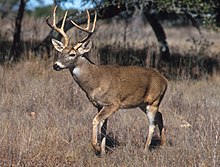
White-tailed deer
All male deer possess antlers, with the exception of the Chinese water deer, in which males have long tusk-like canines that reach below the lower jaw.[23] Females generally lack antlers, though female reindeer bear antlers smaller and less branched than those of the males.[24] Occasionally females in other species may develop antlers, especially in telemetacarpal deer such as European roe deer, red deer, white-tailed deer and mule deer and less often in plesiometacarpal deer. A study of antlered female white-tailed deer noted that antlers tend to be small and malformed, and are shed frequently around the time of parturition.[25]
The fallow deer and the various subspecies of the reindeer have the largest as well as the heaviest antlers, both in absolute terms as well as in proportion to body mass (an average of 8 grams (0.28 oz) per kilogram of body mass);[24][26] the tufted deer, on the other hand, has the smallest antlers of all deer, while the pudú has the lightest antlers with respect to body mass (0.6 grams (0.021 oz) per kilogram of body mass).[24] The structure of antlers show considerable variation; while fallow deer and elk antlers are palmate (with a broad central portion), white-tailed deer antlers include a series of tines sprouting upward from a forward-curving main beam, and those of the pudú are mere spikes.[8] Antler development begins from the pedicel, a bony structure that appears on the top of the skull by the time the animal is a year old. The pedicel gives rise to a spiky antler the following year, that is replaced by a branched antler in the third year. This process of losing a set of antlers to develop a larger and more branched set continues for the rest of the life.[24] The antlers emerge as soft tissues (known as velvet antlers) and progressively harden into bony structures (known as hard antlers), following mineralisation and blockage of blood vessels in the tissue, from the tip to the base.[27]
Antlers might be one of the most exaggerated male secondary sexual characteristics,[28] and are intended primarily for reproductive success through sexual selection and for combat. The tines (forks) on the antlers create grooves that allow another male's antlers to lock into place. This allows the males to wrestle without risking injury to the face.[29] Antlers are correlated to an individual's position in the social hierarchy and its behaviour. For instance, the heavier the antlers, the higher the individual's status in the social hierarchy, and the greater the delay in shedding the antlers;[24] males with larger antlers tend to be more aggressive and dominant over others.[30] Antlers can be an honest signal of genetic quality; males with larger antlers relative to body size tend to have increased resistance to pathogens[31] and higher reproductive capacity.[32]
In elk in Yellowstone National Park, antlers also provide protection against predation by wolves.[33]
Teeth
Most deer bear 32 teeth; the corresponding dental formula is: 0.0.3.33.1.3.3. The elk and the reindeer may be exceptions, as they may retain their upper canines and thus have 34 teeth (dental formula: 0.1.3.33.1.3.3).[34] The Chinese water deer, tufted deer, and muntjac have enlarged upper canine teeth forming sharp tusks, while other species often lack upper canines altogether. The cheek teeth of deer have crescent ridges of enamel, which enable them to grind a wide variety of vegetation.[35] The teeth of deer are adapted to feeding on vegetation, and like other ruminants, they lack upper incisors, instead having a tough pad at the front of their upper jaw.
Biology

Fawn
Diet
Deer are browsers, and feed primarily on leaves. They have small, unspecialized stomachs by ruminant standards, and high nutrition requirements. Rather than eating and digesting vast quantities of low-grade fibrous food as, for example, sheep and cattle do, deer select easily digestible shoots, young leaves, fresh grasses, soft twigs, fruit, fungi, and lichens. The low-fibered food, after minimal fermentation and shredding, passes rapidly through the alimentary canal. The deer require a large amount of minerals such as calcium and phosphate in order to support antler growth, and this further necessitates a nutrient-rich diet. There are, however, some reports of deer engaging in carnivorous activity, such as depredating the nests of Northern bobwhites.[36]
Reproduction
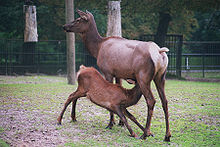
Female elk nursing young
Nearly all cervids are so-called uniparental species: the fawns are only cared for by the mother, known as a doe. A doe generally has one or two fawns at a time (triplets, while not unknown, are uncommon). Mating season typically begins in later August and lasts until December. Some species mate until early March. The gestation period is anywhere up to ten months for the European roe deer. Most fawns are born with their fur covered with white spots, though in many species they lose these spots by the end of their first winter. In the first twenty minutes of a fawn's life, the fawn begins to take its first steps. Its mother licks it clean until it is almost free of scent, so predators will not find it. Its mother leaves often to graze, and the fawn does not like to be left behind. Sometimes its mother must gently push it down with her foot.[37] The fawn stays hidden in the grass for one week until it is strong enough to walk with its mother. The fawn and its mother stay together for about one year. A male usually leaves and never sees his mother again, but females sometimes come back with their own fawns and form small herds.
Evolution
Deer are believed to have evolved from antlerless, tusked ancestors that resembled modern duikers and diminutive deer in the early Eocene, and gradually developed into the first antlered cervoids (the superfamily of cervids and related extinct families) in the Miocene. Eventually, with the development of antlers, the tusks as well as the upper incisors disappeared. Thus evolution of deer took nearly 30 million years. Biologist Valerius Geist suggests evolution to have occurred in stages. There are not many prominent fossils to trace this evolution, but only fragments of skeletons and antlers that might be easily confused with false antlers of non-cervid species.[8][38]
Eocene epoch
The ruminants, ancestors of the Cervidae, are believed to have evolved from Diacodexis, the earliest known artiodactyl (even-toed ungulate), 50–55 Mya in the Eocene.[39]Diacodexis, nearly the size of a rabbit, featured the talus bone characteristic of all modern even-toed ungulates. This ancestor and its relatives occurred throughout North America and Eurasia, but were on the decline by at least 46 Mya.[39][40] Analysis of a nearly complete skeleton of Diacodexis discovered in 1982 gave rise to speculation that this ancestor could be closer to the non-ruminants than the ruminants.[41]Andromeryx is another prominent prehistoric ruminant, but appears to be closer to the tragulids.[42]
Oligocene epoch

Leptomeryx
The formation of the Himalayas and the Alps brought about significant geographic changes. This was the chief reason behind the extensive diversification of deer-like forms and the emergence of cervids from the Oligocene to the early Pliocene.[43] The latter half of the Oligocene (28–34 Mya) saw the appearance of the European Eumeryx and the North American Leptomeryx. The latter resembled modern-day bovids and cervids in dental morphology (for instance, it had brachyodont molars), while the former was more advanced.[44] Other deer-like forms included the North American Blastomeryx and the European Dremotherium; these sabre-toothed animals are believed to have been the direct ancestors of all modern antlered deer, though they themselves lacked antlers.[45] Another contemporaneous form was the four-horned protoceratid Protoceras, that was replaced by Syndyoceras in the Miocene; these animals were unique in having a horn on the nose.[38] Late Eocene fossils dated approximately 35 million years ago, which were found in North America, show that Syndyoceras had bony skull outgrowths that resembled non-deciduous antlers.[46]
Miocene epoch
Fossil evidence suggests that the earliest members of the superfamily Cervoidea appeared in Eurasia in the Miocene. Dicrocerus, Euprox and Heteroprox were probably the first antlered cervids.[47]Dicrocerus featured single-forked antlers that were shed regularly.[48]Stephanocemas had more developed and diffuse ("crowned") antlers.[49]Procervulus (Palaeomerycidae), in addition to the tusks of Dremotherium, possessed antlers that were not shed.[50] Contemporary forms such as the merycodontines eventually gave rise to the modern pronghorn.[51]
The Cervinae emerged as the first group of extant cervids around 7–9 Mya, during the late Miocene in central Asia. The tribe Muntiacini made its appearance as † Muntiacus leilaoensis around 7–8 Mya;[52] The early muntjacs varied in size–as small as hares or as large as fallow deer. They had tusks for fighting and antlers for defence.[8] Capreolinae followed soon after; Alceini appeared 6.4–8.4 Mya.[53] Around this period, the Tethys Ocean disappeared to give way to vast stretches of grassland; these provided the deer with abundant protein-rich vegetation that led to the development of ornamental antlers and allowed populations to flourish and colonise areas.[8][43] As antlers had become pronounced, the canines were no more retained or were poorly represented (as in elk), probably because diet was no more browse-dominated and antlers were better display organs. In muntjac and tufted deer, the antlers as well as the canines are small. The tragulids, however, possess long canines to this day.[40]
Pliocene epoch
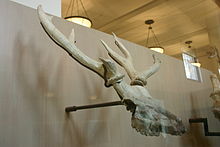
Cervocerus novorossiae
With the onset of the Pliocene, the global climate became cooler. A fall in the sea-level led to massive glaciation; consequently, grasslands abounded in nutritious forage. Thus a new spurt in deer populations ensued.[8][43] The oldest member of Cervini, † Cervocerus novorossiae, appeared around the transition from Miocene to Pliocene (4.2–6 Mya) in Eurasia;[54] cervine fossils from early Pliocene to as late as the Pleistocene have been excavated in China[55] and the Himalayas.[56] While Cervus and Dama appeared nearly 3 Mya, Axis emerged during the late Pliocene–Pleistocene. The tribes Capreolini and Rangiferini appeared around 4–7 Mya.[53]
Around 5 Mya, the rangiferines † Bretzia and † Eocoileus were the first cervids to reach North America.[53] This implies the Bering Strait could be crossed during the late Miocene–Pliocene; this appears highly probable as the camelids migrated into Asia from North America around the same time.[57] Deer invaded South America in the late Pliocene (2.5–3 Mya) as part of the Great American Interchange, thanks to the recently formed Isthmus of Panama, and emerged successful due to the small number of competing ruminants in the continent.[58]
Pleistocene epoch
Large deer with impressive antlers evolved during the early Pleistocene, probably as a result of abundant resources to drive evolution.[8] The early Pleistocene cervid † Eucladoceros was comparable in size to the modern elk.[59]† Megaloceros (Pliocene–Pleistocene) featured the Irish elk (M. giganteus), one of the largest known cervids. The Irish elk reached 2 metres (6.6 ft) at the shoulder and had heavy antlers that spanned 3.6 metres (12 ft) from tip to tip.[60] These large animals are thought to have faced extinction due to conflict between sexual selection for large antlers and body and natural selection for a smaller form.[61] Meanwhile, the moose and reindeer radiated into North America from Siberia.[62]
Taxonomy and classification
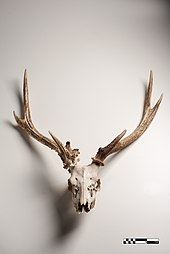
Cervid skull
Deer constitute the artiodactyl family Cervidae. This family was first described by German zoologist Georg August Goldfuss in Handbuch der Zoologie (1820). Three subfamilies are recognised: Capreolinae (first described by the English zoologist Joshua Brookes in 1828), Cervinae (described by Goldfuss) and Hydropotinae (first described by French zoologist Édouard Louis Trouessart in 1898).[2][63]
Other attempts at the classification of deer have been based on morphological and genetic differences.[38] The Anglo-Irish naturalist Victor Brooke suggested in 1878 that deer could be bifurcated into two classes on the according to the features of the second and fifth metacarpal bones of their forelimbs: Plesiometacarpalia (most Old World deer) and Telemetacarpalia (most New World deer). He treated the musk deer as a cervid, placing it under Telemetacarpalia. While the telemetacarpal deer showed only those elements located far from the joint, the plesiometacarpal deer retained the elements closer to the joint as well.[64] Differentiation on the basis of diploid number of chromosomes in the late 20th century has been flawed by several inconsistencies.[38]
In 1987, the zoologists Colin Groves and Peter Grubb identified three subfamilies: Cervinae, Hydropotinae and Odocoileinae; they noted that the hydropotines lack antlers, and the other two subfamilies differ in their skeletal morphology.[65] However, they reverted from this classification in 2000.[66]
External relationships
Until the beginning of the 21st century it was understood that the family Moschidae (musk deer) is sister to Cervidae. However, a 2003 phylogenetic study by Alexandre Hassanin (of National Museum of Natural History, France) and colleagues, based on mitochondrial and nuclear analyses, revealed that Moschidae and Bovidae form a clade sister to Cervidae. According to the study, Cervidae diverged from the Bovidae-Moschidae clade 27 to 28 million years ago.[67] A similar study in 2013 echoed the findings of this study.[68] The following cladogram is based on the 2003 study.[67]
.mw-parser-output table.cladeborder-spacing:0;margin:0;font-size:100%;line-height:100%;border-collapse:separate;width:auto.mw-parser-output table.clade table.cladewidth:100%.mw-parser-output table.clade tdborder:0;padding:0;vertical-align:middle;text-align:center.mw-parser-output table.clade td.clade-labelwidth:0.8em;border:0;padding:0 0.2em;vertical-align:bottom;text-align:center.mw-parser-output table.clade td.clade-slabelborder:0;padding:0 0.2em;vertical-align:top;text-align:center.mw-parser-output table.clade td.clade-barvertical-align:middle;text-align:left;padding:0 0.5em.mw-parser-output table.clade td.clade-leafborder:0;padding:0;text-align:left;vertical-align:middle.mw-parser-output table.clade td.clade-leafRborder:0;padding:0;text-align:right
Ruminantia |
| |||||||||||||||||||||||||||
| |
Internal relationships
A 2006 phylogenetic study of the internal relationships in Cervidae by Clément Gilbert and colleagues divided the family into two major clades: Capreolinae (telemetacarpal or New World deer) and Cervinae (plesiometacarpal or Old World deer). Studies in the late 20th century suggested a similar bifurcation in the family. This as well as previous studies support monophyly in Cervinae, while Capreolinae appears paraphyletic. The 2006 study identified two lineages in Cervinae, Cervini (comprising the genera Axis, Cervus, Dama and Rucervus) and Muntiacini (Muntiacus and Elaphodus). Capreolinae featured three lineages, Alceini (Alces species), Capreolini (Capreolus and the subfamily Hydropotinae) and Rangiferini (Blastocerus, Hippocamelus, Mazama, Odocoileus, Pudu and Rangifer species). The following cladogram is based on the 2006 study.[53]
Cervidae |
| ||||||||||||||||||||||||||||||||||||||||||||||||||||||||||||||||||||||||||||||||||||||||||||||||||||||||||||||||||||||||||||||||||||
| |
Extant subfamilies, genera and species
The subfamily Capreolinae consists of 9 genera and 36 species, while Cervinae comprises 10 genera and 55 species.[63]Hydropotinae consists of a single species, the water deer (H. inermis); however, a 1998 study placed it under Capreolinae.[69] The following list is based on molecular and phylogenetic studies by zoologists such as Groves and Grubb.[70][71][72][73][74]
Subfamily Capreolinae (Odocoileinae or New World deer)
Tribe Alceini- Genus Alces
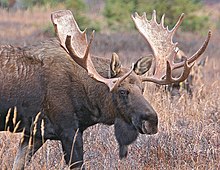
Moose, the largest species of deer
Moose or Eurasian elk (A. alces)
Tribe Capreolini- Genus Capreolus
Western roe deer (C. capreolus)
Eastern roe deer (C. pygargus; considered a subspecies of the western roe deer until the late 20th century)
- Genus Capreolus
Tribe Rangiferini or Odocoileini (reindeer and New World deer)- Genus Blastocerus
Marsh deer (B. dichotomus)
- Genus Hippocamelus
Taruca (H. antisensis)
Huemul (H. bisulcus)
- Genus Mazama
Gray brocket (M. gouazoubira)
Amazonian brown brocket (M. nemorivaga; sometimes considered to be a subspecies of the gray brocket)
Brazilian brocket (M. superciliaris; sometimes considered to be a subspecies of the gray brocket)
Colombian brocket (M. sanctaemartae; sometimes considered to be a subspecies of gray brocket)
Ecuador brocket (M. murelia; sometimes considered to be a subspecies of the gray brocket)
Isla San Jose brocket (M. permira; sometimes considered to be a subspecies of the gray brocket)
Northern Venezuelan brocket (M. cita; sometimes considered to be a subspecies of gray brocket)
Peruvian brocket (M. tschudii; sometimes considered to be a subspecies of the gray brocket)
Rodon (M. rondoni; sometimes considered to be a subspecies of the gray brocket)
Little red brocket (M. rufina)
Pygmy brocket (M. nana; sometimes considered to be a subspecies of little red brocket)
Merida brocket (M. bricenii)
Dwarf brocket (M. chunyi; sometimes considered a subspecies of the Merida brocket)
Red brocket (M. americana)
Brazilian red brocket (M. jucunda; sometimes considered to be a subspecies of the red brocket)
Central American red brocket (M. temama; sometimes considered to be a subspecies of the red brocket)
Colombian red brocket (M. zetta; sometimes considered to be a subspecies of the red brocket)
Ecuador red brocket (M. gualea; sometimes considered to be a subspecies of the red brocket)
Peruvian red brocket (M. zamora; sometimes considered to be a subspecies of the red brocket)
Southern red brocket (M. whitelyi; sometimes considered to be a subspecies of the red brocket)
Trinidad red brocket (M. trinitatis; sometimes considered to be a subspecies of the red brocket)
Small red brocket or Bororo (M. bororo)
Yucatan brown brocket (M. pandora; formerly considered to be a subspecies of the gray brocket or the red brocket)
- Genus Odocoileus
Mule deer (O. hemionus)
White-tailed deer (O. virginianus)
- Genus Ozotoceros
Pampas deer (O. bezoarticus)
- Genus Pudu

Pudú, the smallest species of deer
Northern pudú (P. mephistophiles)
Southern pudú (P. pudu)
- Genus Rangifer
Reindeer or caribou (R. tarandus)
- Genus Blastocerus
- Subfamily Cervinae (Old World deer)

Tufted deer, along with other muntjacs and the water deer, are the only living cervids with tusks.
Tribe Cervini (true deer)- Genus Axis (formerly considered to be a subgenus of Cervus)
Chital (A. axis)
Sri Lankan axis deer (A. axis ceylonensis)
- Genus Cervus
Red deer (C. elaphus)
Maral deer (C. maral; sometimes considered to be a subspecies of the west European red deer)
Corsican red deer (C. corsicanus; sometimes considered to be a subspecies of the west European red deer)
Yarkand deer (C. yarkandensis; sometimes considered to be a subspecies of the west European red deer)
Bactrian deer (C. bactrianus; sometimes considered to be a subspecies of the west European red deer)
Thorold's deer (C. albirostris)
Sika deer (C. nippon)
Vietnamese deer (C. pseudaxis; sometimes considered to be a subspecies of the sika deer)
Tsushima Island deer (C. pulchellus; sometimes considered to be a subspecies of the sika deer)
Formosan deer (C. taiouanus; sometimes considered to be a subspecies of the sika deer)
Kashmir wapiti (C. hanglu; sometimes considered to be a subspecies of the west European red deer or the American wapiti)
American wapiti (elk) (C. canadensis)
Manchurian wapiti (C. xanthopygus; sometimes considered to be a subspecies of the American wapiti)
Tibetan wapiti (C. wallichi; sometimes considered to be a subspecies of the American wapiti)
Sichuan wapiti (C. macneilli; sometimes considered to be a subspecies of the American wapiti)
Alashan wapiti (C. alashanicus; sometimes considered to be a subspecies of the American wapiti)
- Genus Dama
Fallow deer (D. dama)
Persian fallow deer (D. mesopotamica)
- Genus Elaphurus

Père David's deer is an extremely endangered species, and extinct in the wild.
Père David's deer (E. davidianus)
- Genus Hyelaphus (formerly considered to be a subgenus of Axis)
Bawean deer (H. kuhlii)
Calamian deer (H. calamianensis)
Hog deer (H. porcinus)
Indochinese hog deer (H. annamiticus; sometimes considered to be a subspecies of the hog deer)
- Genus Panolia[75]
Manipur Eld's deer (P. eldii)
Eastern Eld's deer (P. siamensis; sometimes considered to be a subspecies of the Manipur Eld's deer)
Thamin (P. thamin; sometimes considered to be a subspecies of the Manipur Eld's deer)
- Genus Rucervus
Barasingha (R. duvaucelii)
Eastern swamp deer (R. ranjitsinhi; sometimes considered to be a subspecies of the barasingha)
Western swamp deer (R. branderi; sometimes considered to be a subspecies of the barasingha)
- Genus Rusa (sometimes considered synonymous to Cervus)
Mindanao mountain deer (R. nigellus; sometimes considered to be a subspecies of the Philippine sambar)
Mindoro deer (R. barandanus; sometimes considered to be a subspecies of the Philippine sambar)
Philippine sambar (R. mariannus)
Prince Alfred's deer (R. alfredi)
Javan rusa (R. timorensis)
Sambar deer (R. unicolor)
Southeast Asian sambar (R. equinus; sometimes considered to be a subspecies of the sambar deer)
- Genus Axis (formerly considered to be a subgenus of Cervus)
Tribe Muntiacini- Genus Elaphodus
Tufted deer (E. cephalophus)
- Genus Muntiacus
Annamite muntjac (M. truongsonensis)
Bornean yellow muntjac (M. atherodes)
Fea's muntjac (M. feae)
Giant muntjac (M. vuquangensis)
Gongshan muntjac (M. gongshanensis)
Hairy-fronted muntjac (M. crinifrons)
Javan muntjac (M. muntjak)
Black-legged muntjac (M. nigripes; sometimes considered to be a subspecies of the Javan muntjac)
Indian muntjac (M. aureus; sometimes considered to be a subspecies of the Javan muntjac)
Northern red muntjac (M. vaginalis; sometimes considered to be a subspecies of the Javan muntjac)
Sri Lankan muntjac (M. malabaricus; sometimes considered to be a subspecies of the Javan muntjac)
Leaf muntjac (M. putaoensis)
Pu Hoat muntjac (M. puhoatensis)
Reeves's muntjac (M. reevesi)
Roosevelt's muntjac (M. rooseveltorum)
Sumatran muntjac (M. montanum)
- Genus Elaphodus
Subfamily Hydropotinae
Tribe Hydropotini- Genus Hydropotes
Water deer (H. inermis)
- Genus Hydropotes
Extinct subfamilies, genera and species
The following is the classification of the extinct cervids with known fossil record:
Subfamily Procervulinae (Miocene)[76]- Genus Procervulus
- P. dichotoma
- Genus Procervulus
Subfamily Cervinae (Old World deer)- Tribe Muntiacini (Muntjacs)
- Genus Dicrocerus
- D. elegans
- D. furcatus
- D. necatus
- D. teres
- D. trilateralis
- Genus Euprox[77]
- E. robustus
- E. furcatus
- Genus Eustyloceros[78]
- E. blainvillei
- E. hezhengensis
- E. longchuanensis
- E. maci
- E. pidoplitschkoi
- E. propria
- Genus Muntiacus
- M. leilaoensis
- M. pliocaenicus
- M. polonicus
- Genus Paracervulus[79]
- Genus Stephanocemas[80]
- S. actauensis
- S. aralensis
- S. chinghaiensis
- S. palmatus
- S. rucha
- S. thomsoni
- Genus Dicrocerus
- Tribe Cervini ("true" deer)
- Genus Allocaenelaphus
- Genus Arvernoceros[81]
- A. giuli
- Genus Axis
- A. nesti
- A. eurygonos
- Genus Candiacervus (sometimes considered a subgenus as Megaloceros or synonym of Praemegaceros; Possibly polyphyletic)
- C. rethymnensis
- C. major
- C. dorothensis
- C. ropalophorus
- C. cretensis
- Genus Cervavitus (?subgenus as Megaloceros)
- Genus Cervus
- C. ertborni
- C. falconeri
- C. giganteus
- C. rhenanus
- C. lascrucensis
- Genus Croizetoceros[82]
- C. ramosus
- Genus Dama[83]
- D. dolichopsis
- D. ensifer
- D. laevicornis
- D. virginiana
- D. whitneyi
- Genus Elaphurus
- E. formosanus
- E. meziesianus
- E. bifurcatus
- E. shikamai
- Genus Eucladoceros
- Eucladoceros tetraceros
- Genus Gona
- G. sinhalaya
- Genus Megaloceros
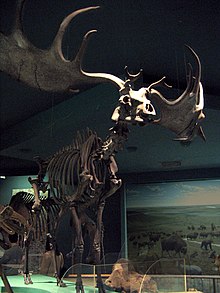
Irish elk, one of the largest cervids ever- M. antecedens
- M. giganteus
- Genus Neomegaloceros
- Genus Nesoleipoceros
- Genus Orchonoceros(sometimes considered a subgenus as Megaloceros)
- Genus Pliocervus[84]
- Genus Praemegaceros (sometimes considered a subgenus as Megaloceros)
- P. obscurus
- P. dawkinsi
- P. savini
- P. verticornis
- P. cazioti
- Genus Praesinomegaceros (sometimes considered a subgenus as Megaloceros)
- P. venustus
- P. asiaticus
- Genus Pselcupsoceros
- Genus Pseudodama[85]
- Genus Rucervus
Schomburgk's deer (R. schomburgki)
Sinomegaceros (sometimes considered a subgenus as Megaloceros)- S. luochuanensis
- S. pachyosteus
- Genus Allocaenelaphus
- Tribe Muntiacini (Muntjacs)
Subfamily Capreolinae (New World or telemetecarpal deer)- Tribe Capreolini
- Genus Bretzia
- B. pseudalces
- B. nebrascensis
- Genus Capreolus
- C. constantini
- C. suessenbornensis
- Genus Cervalces (?= Alces)
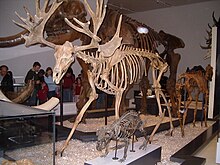
Stag-moose was the largest cervid ever to live.- C. latifrons
- C. scotti
- Genus Libralces (?=Cervalces or Alces)
- L. gallicus
- L. reynoldsi
- Genus Procapreolus
- P. cusanus
- P. moldavicus
- P. stenos
- P. ucrainicus
- Genus Pseudalces
- P. mirandus
- P. wenzensis
- Genus Bretzia
- Tribe Rangiferini
- Genus Agalmaceros
- A. blicki
- Genus Antifer
- A. ultra
- A. crassus
- Genus Blastocerus
- B. extraneus
- B. arpeitianus
- Genus Charitoceros
- Genus Eocoileus
- E. gentryorum
- Genus Epieuryceros
- E. proximus
- E. truncus
- Genus Morenelaphus
- M. lujanensis
- M. brachyceros
- M. fragilis
- Genus Odocoileus
- O. brachyodontus
- O. dolichopsis
- O. laevicornis
- O. sellardsiae
- O. lucasi
- Genus Torontoceros
- T. hypocaeus
- Genus Agalmaceros
- Tribe Capreolini
Human interaction
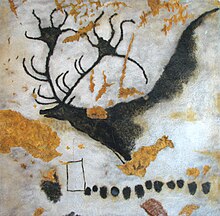
Upper Palaeolithic cave painting of a Megaloceros giant deer at Lascaux, 17,300 years old
In prehistory
Deer were an important source of food for early hominids. In China, Homo erectus fed upon the sika deer, while the red deer was hunted in Germany. In the Upper Palaeolithic, the reindeer was the staple food for Cro-Magnon people,[86] while the cave paintings at Lascaux in southwestern France include some 90 images of stags.[87]
In history
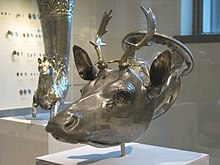
Ancient Greek gilt-silver rhyton, 4th century BC
Deer had a central role in the ancient art, culture and mythology of the Hittites, the ancient Egyptians, the Celts, the ancient Greeks, the Asians and several others. For instance, the Stag Hunt Mosaic of ancient Pella, under the Kingdom of Macedonia (4th century BC), possibly depicts Alexander the Great hunting a deer with Hephaistion.[88] In Japanese Shintoism, the sika deer is believed to be a messenger to the gods. In China, deer are associated with great medicinal significance; deer penis is thought by some in China to have aphrodisiac properties.[89] Spotted deer are believed in China to accompany the god of longevity. Deer was the principal sacrificial animal for the Huichal Indians of Mexico. In medieval Europe, deer appeared in hunting scenes and coats-of-arms. Deer are depicted in many materials by various pre-Hispanic civilizations in the Andes.[86][90]
The common male first name Oscar is taken from the Irish Language, where it is derived from two elements: the first, os, means "deer"; the second element, cara, means "friend". The name is borne by a famous hero of Irish mythology—Oscar, grandson of Fionn Mac Cumhail. The name was popularised in the 18th century by James Macpherson, creator of 'Ossianic poetry'.
In literature
Deer have been an integral part of fables and other literary works since the inception of writing. Stags were used as symbols in the latter Sumerian writings. For instance, the boat of Sumerian god Enki is named the Stag of Azbu. There are several mentions of the animal in the Rigveda as well as the Bible. In the Indian epic Ramayana, Sita is lured by a golden deer which Rama tries to catch. In the absence of both Rama and Lakshman, Ravana kidnaps Sita. Many of the allegorical Aesop's fables, such as "The Stag at the Pool", "The One-Eyed Doe" and "The Stag and a Lion", personify deer to give moral lessons. For instance, "The Sick Stag" gives the message that uncaring friends can do more harm than good.[86] The Yaqui deer song accompanies the deer dance which is performed by a pascola [from the Spanish 'pascua', Easter] dancer (also known as a deer dancer). Pascolas would perform at religious and social functions many times of the year, especially during Lent and Easter.[86][91]
In one of Rudolf Erich Raspe's 1785 stories of Baron Munchausen's Narrative of his Marvellous Travels and Campaigns in Russia, the baron encounters a stag while eating cherries and, without ammunition, fires the cherry-pits at the stag with his musket, but it escapes. The next year, the baron encounters a stag with a cherry tree growing from its head; presumably this is the animal he had shot at the previous year. In Christmas lore (such as in the narrative poem "A Visit from St. Nicholas"), reindeer are often depicted pulling the sleigh of Santa Claus.[92]Marjorie Kinnan Rawlings's Pulitzer Prize-winning 1938 novel The Yearling was about a boy's relationship with a baby deer. The fiction book Fire Bringer is about a young fawn who goes on a quest to save the Herla, the deer kind.[93] In the 1942 Walt Disney Pictures film, Bambi is a white-tailed deer, while in Felix Salten's original 1923 book Bambi, a Life in the Woods, he is a roe deer. In C. S. Lewis's 1950 fantasy novel The Lion, the Witch and the Wardrobe the adult Pevensies, now kings and queens of Narnia, chase the White Stag on a hunt, as the Stag is said to grant its captor a wish. The hunt is key in returning the Pevensies to their home in England. In the 1979 book The Animals of Farthing Wood, The Great White Stag is the leader of all the animals.
Heraldry

Arms of Raon-aux-Bois, France
Deer are represented in heraldry by the stag or hart, or less often, by the hind, and the brocket (a young stag up to two years), respectively. Stag's heads and antlers also appear as charges. The old name for deer was simply cerf, and it is chiefly the head that appears on the ancient arms. Examples of deer in coats of arms can be found in the arms of Hertfordshire, England, and its county town of Hertford; both are examples of canting arms. A deer appears on the arms of the Israeli Postal Authority (see Hebrew language Wikipedia page).[94] Coats of arms featuring deer include those of Dotternhausen, Thierachern, Friolzheim, Bauen, Albstadt, and Dassel in Germany; of the Earls Bathurst in England; of Balakhna, Russia; of Åland, Finland; of Gjemnes, Hitra, Hjartdal, Rendalen and Voss in Norway; of Jelenia Góra, Poland; of Umeå, Sweden; of Cervera, Catalonia; of Northern Ireland; and of Chile.
Economic significance
Deer have long had economic significance to humans. Deer meat, known as venison, is highly nutritious and beneficial for human consumption. Due to the inherently wild nature and diet of deer, venison is most often obtained through deer hunting. In the United States, it is produced in small amounts compared to beef but still represents a significant trade. By 2012, some 25,000 tons of red deer were raised on farms in North America. The major deer-producing countries are New Zealand, the market leader, with Ireland, Great Britain and Germany. The trade earns over $100 million annually for these countries.[95]
The skins make a peculiarly strong, soft leather, known as buckskin. There is nothing special about skins with the fur on since the hair is brittle and soon falls off. The hoofs and horns are used for ornamental purposes, especially the antlers of the roe deer, which are utilized for making umbrella handles, and for similar purposes; elk horn is often employed in making knife handles. In China, a medicine is made from stag horn, and the antlers of certain species are eaten when "in the velvet".[96] Among the Inuit, the traditional ulu women's knife was made with an antler, horn, or ivory handle.[97]
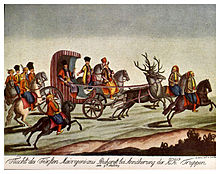
Nicholas Mavrogenes, Phanariote Prince of Wallachia, riding through Bucharest in a stag−drawn carriage. Late 1780s
Deer have long been bred in captivity as ornaments for parks, but only in the case of reindeer has thorough domestication succeeded.[96] The Sami of Scandinavia and the Kola Peninsula of Russia and other nomadic peoples of northern Asia use reindeer for food, clothing, and transport. Deer bred for hunting are selected based on the size of the antlers.[98] In North America, the reindeer, known there as caribou, is not domesticated or herded, but it is important as a quarry animal to the Caribou Inuit.[99]
Automobile collisions with deer can impose a significant cost on the economy. In the U.S., about 1.5 million deer-vehicle collisions occur each year, according to the National Highway Traffic Safety Administration. Those accidents cause about 150 human deaths and $1.1 billion in property damage annually.[100] In Scotland, several roads including the A82, the A87 and the A835 have had significant enough problems with deer vehicle collisions (DVCs) that sets of vehicle activated automatic warning signs have been installed along these roads.[101]
In some areas of the UK, deer (especially fallow deer due to their gregarious behaviour), have been implicated as a possible reservoir for transmission of bovine tuberculosis,[102][103] a disease which in the UK in 2005 cost £90 million in attempts to eradicate.[104] In New Zealand, deer are thought to be important as vectors picking up M. bovis in areas where brushtail possums Trichosurus vulpecula are infected, and transferring it to previously uninfected possums when their carcasses are scavenged elsewhere.[105] The white-tailed deer Odocoileus virginianus has been confirmed as the sole maintenance host in the Michigan outbreak of bovine tuberculosis which remains a significant barrier to the US nationwide eradication of the disease in livestock. In 2008, 733,998 licensed deer hunters killed approximately 489,922 white-tailed deer to procure venison, control the deer population, and minimize the spread of disease. These hunters purchased more than 1.5 million deer harvest tags. The economic value of deer hunting to Michigan's economy is substantial. For example, in 2006, hunters spent US$507 million hunting white-tailed deer in Michigan.[106]
Deer hunting is a popular activity in the U.S. that provides the hunter's family with high quality meat and generates revenue for states and the federal government from the sales of licenses, permits and tags. The 2006 survey by the U.S. Fish and Wildlife Service estimates that license sales generate approximately $700 million annually. This revenue generally goes to support conservation efforts in the states where the licenses are purchased. Overall, the U.S. Fish and Wildlife Service estimates that big game hunting for deer and elk generates approximately $11.8 billion annually in hunting-related travel, equipment and related expenditures.[107]
Etymology
The word deer was originally broad in meaning, becoming more specific with time. Old English dēor and Middle English der meant a wild animal of any kind. Cognates of Old English dēor in other dead Germanic languages have the general sense of animal, such as Old High German tior, Old Norse djur or dȳr, Gothic dius, Old Saxon dier, and Old Frisian diar.[108] This general sense gave way to the modern English sense by the end of the Middle English period, around 1500. However, all modern Germanic languages save English and Scots retain the more general sense: for example, German Tier and Norwegian dyr mean animal.[109]
Terminology

"The Stag Hunt of Frederick III, Elector of Saxony" by Lucas Cranach the Elder, 1529
For many types of deer in modern English usage, the male is a buck and the female a doe, but the terms vary with dialect, and according to the size of the species. The male red deer is a stag, while for other large species the male is a bull, the female a cow, as in cattle. In older usage, the male of any species is a hart, especially if over five years old, and the female is a hind, especially if three or more years old.[110] The young of small species is a fawn and of large species a calf; a very small young may be a kid. A castrated male is a havier.[111] A group of any species is a herd. The adjective of relation is cervine; like the family name Cervidae, this is from Latin: cervus, meaning stag or deer.
See also
- Deer management
- Australian Deer Association
- Deer forest
- Reindeer hunting in Greenland
References
^ McLintock, A. H., ed. (1966). "Deer". Te Ara: An Encyclopaedia of New Zealand..mw-parser-output cite.citationfont-style:inherit.mw-parser-output qquotes:"""""""'""'".mw-parser-output code.cs1-codecolor:inherit;background:inherit;border:inherit;padding:inherit.mw-parser-output .cs1-lock-free abackground:url("//upload.wikimedia.org/wikipedia/commons/thumb/6/65/Lock-green.svg/9px-Lock-green.svg.png")no-repeat;background-position:right .1em center.mw-parser-output .cs1-lock-limited a,.mw-parser-output .cs1-lock-registration abackground:url("//upload.wikimedia.org/wikipedia/commons/thumb/d/d6/Lock-gray-alt-2.svg/9px-Lock-gray-alt-2.svg.png")no-repeat;background-position:right .1em center.mw-parser-output .cs1-lock-subscription abackground:url("//upload.wikimedia.org/wikipedia/commons/thumb/a/aa/Lock-red-alt-2.svg/9px-Lock-red-alt-2.svg.png")no-repeat;background-position:right .1em center.mw-parser-output .cs1-subscription,.mw-parser-output .cs1-registrationcolor:#555.mw-parser-output .cs1-subscription span,.mw-parser-output .cs1-registration spanborder-bottom:1px dotted;cursor:help.mw-parser-output .cs1-hidden-errordisplay:none;font-size:100%.mw-parser-output .cs1-visible-errorfont-size:100%.mw-parser-output .cs1-subscription,.mw-parser-output .cs1-registration,.mw-parser-output .cs1-formatfont-size:95%.mw-parser-output .cs1-kern-left,.mw-parser-output .cs1-kern-wl-leftpadding-left:0.2em.mw-parser-output .cs1-kern-right,.mw-parser-output .cs1-kern-wl-rightpadding-right:0.2em
^ ab Groves, C. (2007). "Family Cervidae". In Prothero, D. R.; Foss, S. E. The Evolution of Artiodactyls (Illustrated ed.). Baltimore, USA: Johns Hopkins University Press. pp. 249–56. ISBN 978-0-801-88735-2.
^ Kingdon, J. (2015). The Kingdon Field Guide to African Mammals (2nd ed.). London, UK: Bloomsbury Publishing. p. 499. ISBN 978-1-4729-2531-2.
^ Jameson, E. W.; Peeters, H. J., Jr. (2004). Mammals of California (Revised ed.). Berkeley, USA: University of California Press. p. 241. ISBN 978-0-520-23582-3.
^ Long, C. A. (2008). The Wild Mammals of Wisconsin. Sofia, Bulgaria: Pensoft. p. 439. ISBN 9789546423139.
^ Prothero, D. R.; Schoch, R. M. (2002). Horns, Tusks, and Flippers: The Evolution of Hoofed Mammals. Baltimore, USA: Johns Hopkins University Press. pp. 61–84. ISBN 978-0-8018-7135-1.
^ ab Kurta, A. (1995). Mammals of the Great Lakes Region (1st ed.). Michigan, USA: University of Michigan Press. pp. 260–1. ISBN 978-0-472-06497-7.
^ abcdefg Geist, V. (1998). Deer of the World: Their Evolution, Behaviour and Ecology (1st ed.). Mechanicsburg, USA: Stackpole Books. pp. 1–54. ISBN 978-0-8117-0496-0.
^ Armstrong, D. M.; Fitzgerald, J. P.; Meaney, C. A. (2011). Mammals of Colorado (2nd ed.). Colorado, USA: University Press of Colorado. p. 445. ISBN 978-1-60732-048-7.
^ Kingdon, J.; Happold, D.; Butynski, T.; Hoffmann, M.; Happold, M.; Kalina, J. (2013). Mammals of Africa. VI. London, UK: Bloomsbury Publishing. p. 116. ISBN 978-1-4081-8996-2.
^ ab Feldhamer, G. A.; McShea, W. J. (2012). Deer: The Animal Answer Guide. Baltimore, USA: Johns Hopkins University Press. pp. 1–142. ISBN 978-1-4214-0387-8.
^ Francis, C. M. (2008). A Field Guide to the Mammals of South-East Asia. London, UK: New Holland. p. 130. ISBN 978-1-84537-735-9.
^ Trolle, M.; Emmons, L. H. (2004). "A record of a dwarf brocket from Lowland Madre De Dios, Peru" (PDF). Deer Specialist Group News (19): 2–5.
^ Schmidly, D. J. (2004). The Mammals of Texas (Revised ed.). Austin, Texas (USA): University of Texas Press. pp. 263–4. ISBN 978-1-4773-0886-8.
^ Hames, D. S.; Koshowski, Denise (1999). Hoofed Mammals of British Columbia. Vancouver, Canada: UBC Press. p. 113. ISBN 978-0-7748-0728-9.
^ Booy, O.; Wade, M.; Roy, H. (2015). Field Guide to Invasive Plants and Animals in Britain. London, UK: Bloomsbury Publishing. p. 170. ISBN 978-1-4729-1153-7.
^ Bowers, N.; Bowers, R.; Kaufmann, K. (2004). Mammals of North America. New York, USA: Houghton Mifflin. pp. 158–9. ISBN 978-0-618-15313-8.
^ Hooey, T. (2004). Strategic Whitetail Hunting. Krause Publications. p. 39. ISBN 978-1-4402-2702-8.
^ Ryder, M. L.; Kay, R. N. B. (1973). "Structure of and seasonal change in the coat of Red deer (Cervus elaphus)". Journal of Zoology. 170 (1): 69–77. doi:10.1111/j.1469-7998.1973.tb05044.x.
^ Lincoln, G. A.; Guinness, F. E. (1972). "Effect of altered photoperiod on delayed implantation and moulting in roe deer" (PDF). Reproduction. 31 (3): 455–7. doi:10.1530/jrf.0.0310455.
^ Owen, James (25 August 2003). "Scottish Deer Are Culprits in Bird Killings". National Geographic News. Retrieved 16 June 2009.
^ Dale, Michael (1988). "Carnivorous Deer". Omni Magazine: 31.
^ Burton, M.; Burton, R. (2002). International Wildlife Encyclopedia (3rd ed.). New York, US: Marshall Cavendish. pp. 446–7. ISBN 978-0-7614-7270-4.
^ abcde Hall, B. K. (2005). Bones and Cartilage: Developmental and Evolutionary Skeletal Biology. Amsterdam, Netherlands: Elsevier Academic Press. pp. 103–15. ISBN 978-0-08-045415-3.
^ Wislocki, G. B. (1954). "Antlers in female deer, with a report of three cases in Odocoileus". Journal of Mammalogy. 35 (4): 486–95. doi:10.2307/1375571. JSTOR 1375571.
^ Smith, T. (2013). The Real Rudolph: A Natural History of the Reindeer. New York, US: The History Press. ISBN 978-0-7524-9592-7.
^ Fletcher, T. J. (1986). "Reproduction: seasonality". In Alexander, T. L.; Buxton, D. Management and Diseases of Deer: A Handbook for the Veterinary Surgeon (2nd ed.). London, UK: Veterinary Deer Society. pp. 17–8. ISBN 978-0-9510826-0-7.
^ Malo, A. F.; Roldan, E. R. S.; Garde, J.; Soler, A. J.; Gomendio, M. (2005). "Antlers honestly advertise sperm production and quality". Proceedings of the Royal Society B: Biological Sciences. 272 (1559): 149–57. doi:10.1098/rspb.2004.2933. PMC 1634960. PMID 15695205.
^ Emlen, D. J. (2008). "The evolution of animal weapons". Annual Review of Ecology, Evolution, and Systematics. 39: 387–413. doi:10.1146/annurev.ecolsys.39.110707.173502.
^ Bowyer, R. T. (1986). "Antler characteristics as related to social status of male southern mule deer". The Southwestern Naturalist. 31 (3): 289–98. doi:10.2307/3671833. JSTOR 3671833.
^ Ditchkoff, S. S.; Lochmiller, R. L.; Masters, R. E.; Hoofer, S. R.; Den Bussche, R. A. Van (2001). "Major-histocompatibility-complex-associated variation in secondary sexual traits of white-tailed deer (Odocoileus virginianus) evidence for good-genes advertisement". Evolution. 55 (3): 616–625. doi:10.1111/j.0014-3820.2001.tb00794.x. PMID 11327168.
^ Malo, A. F.; Roldan, E. R. S.; Garde, J.; Soler, A. J.; Gomendio, M. (2005). "Antlers honestly advertise sperm production and quality". Proceedings of the Royal Society B: Biological Sciences. 272 (1559): 149–157. doi:10.1098/rspb.2004.2933. PMC 1634960. PMID 15695205.
^ Metz, Matthew C.; Emlen, Douglas J.; Stahler, Daniel R.; MacNulty, Daniel R.; Smith, Douglas W. (2018-09-03). "Predation shapes the evolutionary traits of cervid weapons". Nature Ecology & Evolution. 2: 1619–1625.|access-date=requires|url=(help)
^ Reid, F. A. (2006). A Field Guide to Mammals of North America, North of Mexico (4th ed.). Boston, USA: Houghton Mifflin Co. pp. 153–4. ISBN 978-0-395-93596-5.
^ Cockerill, R. (1984). Macdonald, D., ed. The Encyclopedia of Mammals. New York, USA: Facts on File. pp. 520–9. ISBN 978-0-87196-871-5.
^ Ellis-Felege, S. N.; Burnam, J. S.; Palmer, W. E.; Sisson, D. C.; Wellendorf, S. D.; Thornton, R. P.; Stribling, H. L.; Carroll, J. P. (2008). "Cameras identify White-tailed deer depredating Northern bobwhite nests". Southeastern Naturalist. 7 (3): 562–564. doi:10.1656/1528-7092-7.3.562.
^ Deer – info and games Sheppard Software.
^ abcd Goss, R. J. (1983). Deer Antlers Regeneration, Function and Evolution. Oxford, UK: Elsevier. pp. 43–51. ISBN 9780323140430.
^ ab Janis, C. M.; Effinger, J. A.; Harrison, J. A.; Honey, J. G.; Kron, D. G.; Lander, B.; Manning, E.; Prothero, D.; Stevens, M. S.; Stucky, R. K.; Webb, S. D.; Wright, D. B. (1998). "Artiodactyla". In Janis, C. M.; Scott, K. M.; Jacobs, L. L. Evolution of Tertiary Mammals of North America (1st ed.). Cambridge, UK: Cambridge University Press. pp. 337–74. ISBN 978-0-521-35519-3.
^ ab Heffelfinger, J. (2006). Deer of the Southwest : A Complete Guide to the Natural History, Biology, and Management of Southwestern Mule Deer and White-tailed Deer (1st ed.). Texas, USA: Texas A & M University Press. pp. 1–57. ISBN 978-1-58544-515-8.
^ Rose, K. D. (1982). "Skeleton of Diacodexis, oldest known artiodactyl". Science. 216 (4546): 621–3. Bibcode:1982Sci...216..621R. doi:10.1126/science.216.4546.621. JSTOR 1687682. PMID 17783306.
^ Eldredge, N.; Stanley, S. M., eds. (1984). Living Fossils. New York, USA: Springer. ISBN 978-1-4613-8271-3.
^ abc Ludt, C. J.; Schroeder, W.; Rottmann, O.; Kuehn, R. (2004). "Mitochondrial DNA phylogeography of red deer (Cervus elaphus)" (PDF). Molecular Phylogenetics and Evolution. 31 (3): 1064–83. doi:10.1016/j.ympev.2003.10.003. PMID 15120401.
^ Vislobokova, I.; Daxner-Höck, G. (2001). "Oligocene–early Miocene ruminants from the Valley of Lakes (central Mongolia)" (PDF). Annalen des Naturhistorischen Museums in Wien. A. 103: 213–35. JSTOR 41702231.
^ Stirton, R. A. (1944). "Comments on the relationships of the cervoid family Palaeomerycidae". American Journal of Science. 242 (12): 633–55. Bibcode:1944AmJS..242..633S. doi:10.2475/ajs.242.12.633.
^ Agate Fossil Beds: Agate Fossil Beds National Monument, Nebraska. Interior Department, National Park Service, Division of Publications. p. 31. ISBN 978-0-912627-04-5.
^ Gentry, A. W.; Rössner, G. (1994). "The Miocene differentiation of Old World Pecora (Mammalia)". Historical Biology. 7 (2): 115–58. doi:10.1080/10292389409380449.
^ Azanza, B.; DeMiguel, D.; Andrés, M. (2011). "The antler-like appendages of the primitive deer Dicrocerus elegans: morphology, growth cycle, ontogeny, and sexual dimorphism". Estudios Geológicos. 67 (2): 579–602. doi:10.3989/egeol.40559.207.
^ Wang, X.; Xie, G.; Dong, W. (2009). "A new species of crown-antlered deer Stephanocemas (Artiodactyla, Cervidae) from the middle Miocene of Qaidam Basin, northern Tibetan Plateau, China, and a preliminary evaluation of its phylogeny" (PDF). Zoological Journal of the Linnean Society. 156 (3): 680–95. doi:10.1111/j.1096-3642.2008.00491.x.
^ Ginsburg, L. (1988). "La faune des mammifères des sables Miocènes du synclinal d'Esvres (Val de Loire)" [The mammalian fauna of the Miocene sands of the syncline Esvres (Loire Valley)]. Comptes Rendus de l'Académie des Sciences. II (in French): 319–22.
^ Walker, D. N. (2000). "Pleistocene and Holocene records of Antilocapra americana: a review of the FAUNMAP data" (PDF). Plains Anthropologist. 45 (174): 13–28. JSTOR 25669684.
^ Dong, W.; Pan, Y.; Liu, J. (September 2004). "The earliest Muntiacus (Artiodactyla, Mammalia) from the Late Miocene of Yuanmou, southwestern China" (PDF). Comptes Rendus Palevol. 3 (5): 379–86. doi:10.1016/j.crpv.2004.06.002.
^ abcd Gilbert, C.; Ropiquet, A.; Hassanin, A. (2006). "Mitochondrial and nuclear phylogenies of Cervidae (Mammalia, Ruminantia): Systematics, morphology, and biogeography" (PDF). Molecular Phylogenetics and Evolution. 40 (1): 101–17. doi:10.1016/j.ympev.2006.02.017. PMID 16584894.
^ Di Stefano, G.; Petronio, C. (2002). "Systematics and evolution of the Eurasian Plio-Pleistocene tribe Cervini (Artiodactyla, Mammalia)" (PDF). Geologica Romana. 36: 311–34.
^ Petronio, C.; Krakhmalnaya, T.; Bellucci, L.; Di Stefano, G. (2007). "Remarks on some Eurasian pliocervines: Characteristics, evolution, and relationships with the tribe Cervini". Geobios. 40 (1): 113–30. doi:10.1016/j.geobios.2006.01.002.
^ Ghaffar, A.; Akhtar, M.; Nayyer, A. Q. (2011). "Evidences of Early Pliocene fossil remains of tribe Cervini (Mammalia, Artiodactyla, Cervidae) from the Siwaliks of Pakistan" (PDF). Journal of Animal and Plant Sciences. 21 (4): 830–5.
^ van der Made, J.; Morales, J.; Sen, S.; Aslan, F. (2002). "The first camel from the Upper Miocene of Turkey and the dispersal of the camels into the Old World". Comptes Rendus Palevol. 1 (2): 117–22. doi:10.1016/S1631-0683(02)00012-X.
^ Webb, S. D. (2000). "Evolutionary history of New World Cervidae". In Vrba, E. S.; Schaller, G. B. Antelopes, Deer, and Relatives: Fossil Record, Behavioral Ecology, Systematics, and Conservation. New Haven, USA: Yale University Press. pp. 38–64. ISBN 978-0-300-08142-8.
^ De Vos, J.; Mol, D.; Reumer, J. W. F. (1995). "Early Pleistocene Cervidae (Mammalia, Artiodactyla) from the Oosterschelde (the Netherlands), with a revision of the cervid genus Eucladoceros Falconer, 1868" (PDF). Deinsea (2): 95–121.
^ Lister, A. M.; Gonzalez, S.; Kitchener, A. C. (2000). "Survival of the Irish elk into the Holocene". Nature. 405 (6788): 753–4. Bibcode:2000Natur.405..753G. doi:10.1038/35015668. PMID 10866185.
^ Moen, R. A.; Pastor, J.; Yosef, C. (1999). "Antler growth and extinction of Irish elk" (PDF). Evolutionary Ecology Research (1): 235–49.
^ Breda, M.; Marchetti, M. (2005). "Systematical and biochronological review of Plio-Pleistocene Alceini (Cervidae; Mammalia) from Eurasia". Quaternary Science Reviews. 24 (5–6): 775–805. Bibcode:2005QSRv...24..775B. doi:10.1016/j.quascirev.2004.05.005.
^ ab Wilson, D.E.; Reeder, D.M., eds. (2005). Mammal Species of the World: A Taxonomic and Geographic Reference (3rd ed.). Johns Hopkins University Press. p. 652–70. ISBN 978-0-8018-8221-0. OCLC 62265494.
^ Brooke, V. (1878). "On the classification of the Cervidœ, with a synopsis of the existing species". Proceedings of the Zoological Society of London. 46 (1): 883–928. doi:10.1111/j.1469-7998.1878.tb08033.x.
^ Groves, C.; Grubb, P. (1987). "Relationships of living deer". In Wemmer, C. Biology and Management of the Cervidae : A Conference held at the Conservation and Research Center, National Zoological Park, Smithsonian Institution, Front Royal, Virginia, August 1–5, 1982. Washington, USA: Smithsonian Institution Press. pp. 21–59. ISBN 978-0-87474-981-6.
^ Grubb, P. (2000). "Valid and invalid nomenclature of living and fossil deer, Cervidae" (PDF). Acta Theriologica. 45 (3): 289–307. doi:10.4098/at.arch.00-30.
^ ab Hassanin, A.; Douzery, E. J. P. (2003). "Molecular and morphological phylogenies of Ruminantia and the alternative position of the Moschidae" (PDF). Systematic Biology. 52 (2): 206–28. doi:10.1080/10635150390192726. PMID 12746147.
^ Wang, Q.; Yang, C. (2013). "The phylogeny of the Cetartiodactyla based on complete mitochondrial genomes". International Journal of Biology. 5 (3): 30–6. doi:10.5539/ijb.v5n3p30. Archived from the original on 2018-07-23.
^ Randi, E.; Mucci, N.; Pierpaoli, M.; Douzery, E. (1998). "New phylogenetic perspectives on the Cervidae (Artiodactyla) are provided by the mitochondrial cytochrome b gene". Proceedings of the Royal Society B: Biological Sciences. 265 (1398): 793–801. doi:10.1098/rspb.1998.0362. PMC 1689037. PMID 9628037.
^ Randi, E.; Mucci, N.; Claro-Hergueta, F.; Bonnet, A.; Douzery, E. J. P. (2001). "A mitochondrial DNA control region phylogeny of the Cervinae: Speciation in Cervus and implications for conservation". Animal Conservation. 4 (1): 1–11. doi:10.1017/S1367943001001019.
^ Ludt, C. J.; Schroeder, W.; Rottmann, O.; Kuehn, R. (2004). "Mitochondrial DNA phylogeography of red deer (Cervus elaphus)". Molecular Phylogenetics and Evolution. 31 (3): 1064–83. doi:10.1016/j.ympev.2003.10.003. PMID 15120401.
^ Fernández, M. H.; Vrba, E. S. (2005). "A complete estimate of the phylogenetic relationships in Ruminantia: A dated species-level supertree of the extant ruminants". Biological Reviews. 80 (2): 269–302. doi:10.1017/S1464793104006670. PMID 15921052.
^ Ruiz-García, M.; Randi, E.; Martínez-Agüero, M.; Alvarez, D. (June 2007). "Phylogenetic relationships among Neotropical deer genera (Artiodactyla: Cervidae) by means of mtDNA sequences and microsatellite markers". Revista de Biologia Tropical. 55 (2): 723–41. PMID 19069784.
^ Duarte, J. M. B.; González, S.; Maldonado, J. E. (2008). "The surprising evolutionary history of South American deer". Molecular Phylogenetics and Evolution. 49 (1): 17–22. doi:10.1016/j.ympev.2008.07.009. PMID 18675919.
^ Pitra, C.; Fickel, J.; Meijaard, E.; Groves, C. (2004). "Evolution and phylogeny of old world deer". Molecular Phylogenetics and Evolution. 33 (3): 880–895. doi:10.1016/j.ympev.2004.07.013. PMID 15522810.
^ Gentry, A. W. (1993). "Procervulus Gaudry, 1877 (Mammalia, Artiodactyla): proposed designation of Antilope dichotoma Gervais, 1849 as the type species". The Bulletin of Zoological Nomenclature. 50 (2): 137–9. doi:10.5962/bhl.part.1820.
^ Dong, W.; Liu, J.; Pan, Y. (2003). "A new Euprox from the Late Miocene of Yuanmou, Yunnan Province, China, with interpretation of its paleoenvironment". Chinese Science Bulletin. 48 (5): 485–91. Bibcode:2003ChSBu..48..485D. doi:10.1007/BF03183257.
^ Deng, T. (2014). "A new species of Eostyloceros (Cervidae, Artiodactyla) from the Late Miocene of the Linxia Basin in Gansu, China" (PDF). Zootaxa. 3893 (3): 363–81. doi:10.11646/zootaxa.3893.3.3. PMID 25544527.
^ "Paracervulus". GBIF. Retrieved 14 April 2016.
^ Wang, X.; Xie, G.; Dong, W. (2009). "A new species of crown-antlered deer Stephanocemas (Artiodactyla, Cervidae) from the middle Miocene of Qaidam Basin, northern Tibetan Plateau, China, and a preliminary evaluation of its phylogeny". Zoological Journal of the Linnean Society. 156 (3): 680–95. doi:10.1111/j.1096-3642.2008.00491.x.
^ Petronio, C.; Pandolfi, L. (2011). "First occurrence of the genus Arvernoceros from the late Early Pleistocene in Italy". Rivista Italiana di Paleontoligia e Stratigrafia. 117 (3): 501–8. doi:10.13130/2039-4942/5988.
^ Lindsay, E. H.; Fahlbusch, V.; Mein, P., eds. (1989). European Neogene Mammal Chronology. New York, USA: Plenum Press. p. 205. ISBN 978-1-4899-2513-8.
^ Bulletin of the United States Geological Survey (Report). United States Geological Survey. 1902. pp. 682–6.
^ "Pliocervus". GBIF. Retrieved 14 April 2016.
^ Mazza, P. P. A. (2006). "Poggio Rosso (Upper Valdarno, central Italy), A window on latest Pliocene wildlife". Palaios. 21 (5): 493–8. Bibcode:2006Palai..21..493M. doi:10.2110/palo.2005.P05-033R.
^ abcd Feldhamer, G. A.; McShea, W. J. (2011). Deer: The Animal Answer Guide. Baltimore: Johns Hopkins University Press. pp. 123–32. ISBN 9781421403885.
^ Curtis, Gregory (2006). The Cave Painters: Probing the Mysteries of the World's First Artists (1st ed.). New York: Alfred A. Knopf. pp. 96–97, 102. ISBN 1400043484.
^ Chugg, Andrew (2006). Alexander's Lovers. Raleigh, N.C.: Lulu. pp. 78–79. ISBN 978-1-4116-9960-1.
^ Harding, Andrew (23 September 2006). "Beijing's penis emporium". BBC News. Retrieved 23 June 2010.
^ Berrin, Katherine & Larco Museum (1997) The Spirit of Ancient Peru:Treasures from the Museo Arqueológico Rafael Larco Herrera. New York: Thames and Hudson,
ISBN 0500018022.
^ Harvey, G. (2002). Readings in Indigenous Religions. London: Continuum. p. 109. ISBN 0826451012.
^ Moore, Clement C. (2 December 1823). "An Account of A Visit from St. Nicholas". Troy Sentinel. p. 2. Retrieved 27 March 2015.
^ Clement-Davies, D. (2007). Fire Bringer (1st American ed.). New York: Firebird. ISBN 0142408735.
^ he:רשות הדואר
^ Burden, Dan (June 2012). "Deer Venison Ranching Profile". Agricultural Marketing Resource Center. Retrieved 11 April 2016.
^ ab Rines, George Edwin, ed. (1920). "Deer". Encyclopedia Americana.
Rines, George Edwin, ed. (1920). "Deer". Encyclopedia Americana.
^ "Inuit Bering Sea Eskimo Walrus Ivory and Iron Semi-Lunar Knife 'Ulu' (1800 to 1900 Inuit)". Retrieved 2 October 2018.
^ Laskow, Sarah. "Antler Farm". Medium (service). Retrieved 28 August 2014.
^ "Caribou Inuit". everyculture.com. Retrieved 11 April 2016.
^ "Worst states for auto-deer crashes". CNN.com. 14 November 2006. Retrieved 5 April 2009.
^ "North West Area: Vehicle Activated Deer Warning Signs" (PDF). Transport Scotland. April 2010. 07/NW/0805/046. Retrieved 11 July 2013.
^ Delahay, R. J.; Smith, G. C.; Barlow, A. M.; Walker, N.; Harris, A.; Clifton-Hadley, R. S.; Cheeseman, C. L. (2007). "Bovine tuberculosis infection in wild mammals in the South-West region of England: A survey of prevalence and a semi-quantitative assessment of the relative risks to cattle". The Veterinary Journal. 173 (2): 287–301. doi:10.1016/j.tvjl.2005.11.011. PMID 16434219.
^ Ward, A. I.; Smith, G. C.; Etherington, T. R.; Delahay, R. J. (2009). "Estimating the risk of cattle exposure to tuberculosis posed by wild deer relative to badgers in England and Wales". Journal of Wildlife Diseases. 45 (4): 1104–1120. doi:10.7589/0090-3558-45.4.1104. PMID 19901384.
^ Anonymous (2008). "Bovine TB: EFRACom calls for a multifaceted approach using all available methods". The Veterinary Record. 162 (9): 258–259. doi:10.1136/vr.162.9.258. PMID 18350673.
^ Delahay, R. J.; De Leeuw, A. N. S.; Barlow, A. M.; Clifton-Hadley, R. S.; Cheeseman, C. L. (2002). "The status of Mycobacterium bovis infection in UK wild mammals: A review". The Veterinary Journal. 164 (2): 90–105. doi:10.1053/tvjl.2001.0667. PMID 12359464.
^ O'Brien, D. J.; Schmitt, S. M.; Fitzgerald, S. D.; Berry, D. E. (2011). "Management of bovine tuberculosis in Michigan wildlife: Current status and near term prospects". Veterinary Microbiology. 151 (1–2): 179–187. doi:10.1016/j.vetmic.2011.02.042. PMID 21414734.
^ "U.S. Department of the Interior, Fish and Wildlife Service, and U.S. Department of Commerce, U.S. Census Bureau. 2006 National Survey of Fishing, Hunting, and Wildlife-Associated Recreation" (PDF). Retrieved 16 November 2012.
^ "deer". The American Heritage Dictionary of the English Language (4th ed.). Houghton Mifflin Company. 2000. Archived from the original on 25 March 2004.
^ Harper, Douglas. "Deer". Online Etymology Dictionary. Retrieved 7 June 2012.
^ OED, s.v. hart and hind
^ "Havier". Dictionary.com. Retrieved 4 August 2012.
Further reading
Deerland: America's Hunt for Ecological Balance and the Essence of Wildness by Al Cambronne, Lyons Press (2013),
ISBN 978-0-7627-8027-3
External links
Wikispecies has information related to Cervidae |
| Look up deer in Wiktionary, the free dictionary. |
| Wikimedia Commons has media related to Cervidae. |
Family Cervidae at the Animal Diversity Web- Chronic Wasting Disease Information
- Encyclopedia of Oklahoma History and Culture – Deer
 "Deer". The New Student's Reference Work. 1914.
"Deer". The New Student's Reference Work. 1914.
















